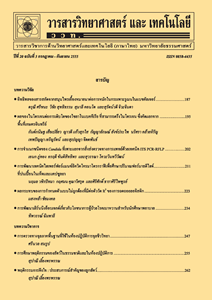การศึกษาปริมาณผงฟักข้าวและวิธีการอบแห้งที่เหมาะสมในการผลิตปลาแผ่น
Main Article Content
Abstract
บทคัดย่อ
งานวิจัยนี้มีวัตถุประสงค์เพื่อศึกษาสภาวะการผลิตและปริมาณผงฟักข้าวต่อลักษณะคุณภาพด้านต่าง ๆ และการเปลี่ยนแปลงระหว่างเก็บรักษาของปลาแผ่น โดยผลิตปลาแผ่นที่เติมผงฟักข้าวร้อยละ 0 และ 3 นำมาอบแห้งโดยใช้ตู้อบลมร้อนและไมโครเวฟร่วมกับตู้อบลมร้อน พบว่าปลาแผ่นที่เติมผงฟักข้าวร้อยละ 3 ทั้ง 2 สภาวะ การอบแห้งมีค่า L* ลดลงและ a* เพิ่มขึ้น (P≤0.05) ปลาแผ่นสูตรเติมผงฟักข้าวร้อยละ 0 อบแห้งด้วยลมร้อนอุณหภูมิ 60 องศาเซลเซียส (0 : H60) มีปริมาณความชื้นน้อยที่สุด (P≤0.05) และปลาแผ่นสูตรเติมผงฟักข้าวร้อยละ 0 อบด้วยไมโครเวฟร่วมกับลมร้อนที่กำลังไมโครเวฟ 600 วัตต์ (0 : M600H) มีค่า fracturability น้อยที่สุด (P≤0.05) ผลการทดสอบความชอบของผู้ทดสอบชิม พบว่าปลาแผ่นสูตร 3 : M600H มีคะแนนความชอบด้านสีสูงสุด ปลาแผ่นสูตร 0 : H60 มีคะแนนความชอบด้านกลิ่น รสชาติ และความชอบโดยรวมสูงสุด (P≤0.05) ผู้วิจัยเลือกปลาแผ่นสูตร 0 : H60 และสูตร 3 : M600H เพื่อใช้ในการศึกษาขั้นต่อไป ผลการศึกษาองค์ประกอบทางเคมีพบว่าปลาแผ่นสูตร 3 : M600H มีปริมาณความชื้น โปรตีน ไขมัน และใยอาหารเพิ่มขึ้น ปริมาณเถ้าและคาร์โบไฮเดรตลดลง และปริมาณไลโคปีน 0.2935 mg/100g การเปลี่ยนแปลงในระหว่างการเก็บรักษาในถุงฟอยล์อลูมิเนียมลามิเนตที่อุณหภูมิห้อง พบว่า ปลาแผ่นทั้ง 2 สูตร ค่า L* มีแนวโน้มลดลงเมื่อระยะเวลาการเก็บเพิ่มขึ้น ส่วนค่า aw ค่า fracturability และค่า TBA มีแนวโน้มเพิ่มขึ้นเมื่อระยะเวลาการเก็บรักษาเพิ่มขึ้น
คำสำคัญ : ฟักข้าวว; ปลาแผ่น; ไมโครเวฟ
Abstract
The present study aims at studying the production conditions and the amounts of Gac powder determining the quality characteristics and the changes during a storage time. The amounts of Gac powder at 0 and 3 % were added into the production process, and were dried using hot-air dryer and microwave hot-air heater. The results showed that both drying conditions of fish snack with the amount of Gac powder at 3 % revealed the reduction of L* value and the increment of a* value (P≤0.05). The fish snack added with the amount of Gac powder at 0 % drying with hot-air dryer at 60 ºC (0 : H60) showed the lowest moisture content (P≤0.05). In addition, the fish snack added with the amount of Gac powder at 0 % drying with microwave hot-air heater showed the lowest fracturability (0 : M600H) (P≤0.05). The sensory evaluation pointed out that the 3 : M600H fish snack gained the highest hedonic score in terms of color, and the 0 : H60 fish snack gained the highest hedonic score in terms of odor, taste and overall preference (P≤0.05). Consequently, the 0 : H60 and 3 : M600H fish snacks were selected for further study. The analysis of chemical composition of 3 : M600H fish snack indicated the increment of the moisture content, protein, fat and fiber. Whereas, the reduction of ash and carbohydrate occurred with the lycopene contents of 0.2935 mg/100 g. By taking changes during a storage time in laminated aluminum foil bag at room temperature in consideration, the results indicated that both formulas tentatively showed the reduction of L* value according to the duration of storage time. Whereas, the value of water activity tentatively showed the increment of fracturability and TBA values according to the duration of storage time.
Keywords: gac; fak kao; fish snack; microwave


